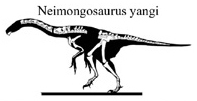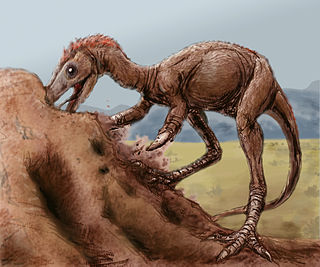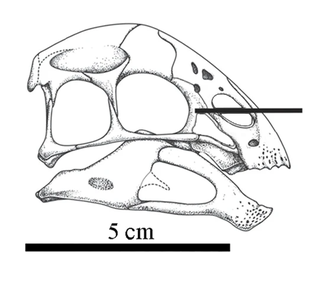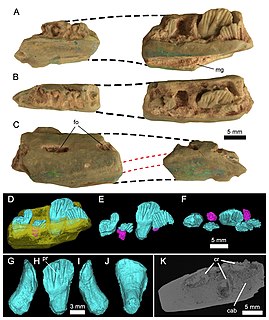Notable dinosaur specimens can individually increase science's knowledge about the life and world of the dinosaurs.

Archaeoceratops, meaning "ancient horned face", is a genus of basal neoceratopsian dinosaur from the Early Cretaceous of north central China. It appears to have been bipedal and quite small with a comparatively large head. Unlike many later ceratopsians it had no horns, possessing only a small bony frill projecting from the back of its head.

Scansoriopteryx is a genus of maniraptoran dinosaur. Described from only a single juvenile fossil specimen found in Liaoning, China, Scansoriopteryx is a sparrow-sized animal that shows adaptations in the foot indicating an arboreal (tree-dwelling) lifestyle. It possessed an unusual, elongated third finger which may have supported a membranous wing, much like the related Yi qi. The type specimen of Scansoriopteryx also contains the fossilized impression of feathers.

Mirischia is a small genus of compsognathid theropod dinosaur from the Albian stage of Brazil.

Marasuchus is a genus of basal dinosauriform archosaur which is possibly synonymous with Lagosuchus. Both genera lived during the Late Triassic in what is now La Rioja Province, Argentina. Marasuchus contains a single species, Marasuchus lilloensis.
Yimenosaurus is an extinct genus of plateosaurid sauropodomorph dinosaur that lived in China in the Early Jurassic. The genus was first named in 1990 by Ziqi Bai, Jie Yang and Guohui Wang, along with its type and only species, Yimenosaurus youngi. The species name honours renowned Chinese paleontologist Yang Zhongjian, the father of Chinese paleontology, known as C.C. Young in English. Known material includes the holotype, an almost complete skull and mandible, as well as incomplete cervical and dorsal vertebrae, a mostly complete sacrum, an ilium, ischia, partial ribs and complete femur, and a paratype, a well-preserved postcrania with a fragmentary skull. In 2010 Paul estimated its length at 9 metres (30 ft) and its weight at 2 tonnes.

Pycnonemosaurus is a genus of carnivorous theropod dinosaur that belonged to the family Abelisauridae. It was found in the Upper Cretaceous red conglomerate sandstones of the "Cabembe Unit", Mato Grosso, Brazil, and it lived about 70 million years ago during the Late Cretaceous.

Neimongosaurus is a genus of herbivorous therizinosaur theropod dinosaur that lived in Asia during the Cenomanian stage of the Late Cretaceous period in what is now the Iren Dabasu Formation.

Mantellisaurus is a genus of iguanodontian dinosaur that lived in the Barremian and early Aptian ages of the Early Cretaceous Period of Europe. Its remains are known from Belgium (Bernissart), England, Spain and Germany. The type and only species is M. atherfieldensis. Formerly known as Iguanodon atherfieldensis, the new genus Mantellisaurus was erected for the species by Gregory Paul in 2007. According to Paul, Mantellisaurus was more lightly built than Iguanodon and more closely related to Ouranosaurus, making Iguanodon in its traditional sense paraphyletic. It is known from many complete and almost complete skeletons. The genus name honours Gideon Mantell, the discoverer of Iguanodon.

Skorpiovenator is a genus of abelisaurid theropod dinosaur from the Late Cretaceous Huincul Formation of Argentina. It is one of the most complete and informative abelisaurids yet known, described from a nearly complete and articulated skeleton.

Kol is an extinct genus of alvarezsaurid theropod dinosaur from the Late Cretaceous of Mongolia. The type and only species is Kol ghuva. The type specimen was excavated from the Ukhaa Tolgod locality of the Djadochta Formation, dating to about 75 million years ago. It is believed to have been about twice the size of the contemporary Shuvuuia. However, unlike Shuvuuia, which is known from many well preserved specimens, and although Ukhaa Tolgod has been thoroughly explored, Kol is known only from one complete foot, suggesting that it must have been relatively rare in that ecosystem.

Qiupalong is a genus of extinct ornithomimid theropods from the Late Cretaceous of what is now China and Canada.

Propanoplosaurus is a genus of herbivorous nodosaurid dinosaur from the Early Cretaceous Patuxent Formation of Maryland, USA. Its type specimen is a natural cast and partial natural mold of a hatchling.

Paleontology in Connecticut refers to paleontological research occurring within or conducted by people from the U.S. state of Connecticut. Apart from its famous dinosaur tracks, the fossil record in Connecticut is relatively sparse. The oldest known fossils in Connecticut date back to the Triassic period. At the time, Pangaea was beginning to divide and local rift valleys became massive lakes. A wide variety of vegetation, invertebrates and reptiles are known from Triassic Connecticut. During the Early Jurassic local dinosaurs left behind an abundance of footprints that would later fossilize.

Yulong is an extinct genus of derived oviraptorid theropod dinosaur known from the Late Cretaceous Qiupa Formation of Henan Province, central China. It contains a single species, Yulong mini. It is known from many juvenile specimens that represent some of the smallest known oviraptorids.
Ningyuansaurus is a basal oviraptorosaurian dinosaur genus. It contains the single species Ningyuansaurus wangi, known from a fossil specimen from the Early Cretaceous Yixian Formation of Jianchang, western Liaoning Province, People's Republic of China. It is thought to be the basalmost species of oviraptorosaur, based on its long skull and a greater number of teeth in comparison to any other known oviraptorosaur. The generic name Ningyuansaurus is derived from Ningyuan, an ancient name for Xingcheng City. The specific name honors Wang Qiuwu, the private owner of the specimen who donated it for scientific study. The specimen is now in the Confuciusornis Museum in Xingcheng.

Zhenyuanlong is a genus of dromaeosaurid dinosaur from the Yixian Formation of Liaoning, China. It lived during the Aptian age of the early Cretaceous period, approximately 125 million years ago. It is known from a single specimen belonging to the species Zhenyuanlong suni. This type specimen preserved a nearly complete skeleton that contains traces of feathers, including long tail feathers and large wings. In addition to further complicating diversity of Liaoning dromaeosaurids, this specimen provides the first evidence of well-developed pennaceous feathers in a large, non-flying dromaeosaur, raising the question of what function such wings would serve.

Buriolestes is a genus of early sauropodomorph dinosaurs from the Late Triassic Santa Maria Formation of the Paraná Basin in southern Brazil. It contains a single species, B. schultzi, named in 2016. The type specimen was found alongside a specimen of the lagerpetid dinosauromorph Ixalerpeton.

Weewarrasaurus is a genus of ornithopod dinosaur from the Late Cretaceous of the Griman Creek Formation near Lightning Ridge, in New South Wales, Australia. The type and only species is W. pobeni, known from the holotype, an isolated dentary preserved in opal, as well as a secondary referred dentary. It is thought to have co-existed with multiple other ornithopods of different sizes and lineages.

Changmiania is a genus of basal ornithopod dinosaur that lived in what is now China during the Early Cretaceous. It contains a single species, Changmiania liaoningensis.
Tlatolophus is a genus of hadrosaurid dinosaur belonging to the tribe Parasaurolophini. The only species is the type species, Tlatolophus galorum.